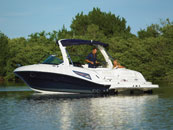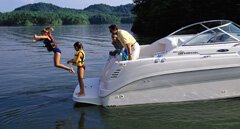With the proliferation of affordable commercial assistance outfits such as Sea Tow and TowBoatU.S. plus the constantly improving reliability of marine engines, it’s not nearly as common as it once was for recreational boaters to tow other boats. That’s a good thing. Safe towing requires the right equipment and a good bit of know-how, and it’s best left to professionals. Occasionally, though, situations still arise in which you have little choice but to accept a tow from a friend or Good Samaritan, or offer one yourself. If you ever find yourself in one of those situations, here are a few things to keep in mind.
1. Avoid coming alongside the other boat. Except in the calmest of conditions, coming alongside another boat is a recipe for trouble. Wave action can slam the boats together, and, worse yet, crewmembers’ extremities can get caught between them. Instead, throw the tow line to the other boat from a distance.
2. If possible, attach the tow line to the bow eye. The bow eye — where the winch strap on the trailer attaches — is generally the best place to attach the tow line to the towed boat. On some boats, though, it can be difficult to reach from inside the boat.
3. Use bowlines to create loops. If you need to tie the tow line around something like a bow eye, use a bowline to make the loop. Bowlines don’t slip and don’t tighten up under pressure — well, they do, but not nearly as much as most other knots. Thus, they can be untied after the tow without too much trouble.
4. Use plenty of line. You should use an absolute minimum of 50 feet of tow line; 100 feet is much better. Remember that the boat in tow has no means of slowing down, so a longer line is an important safety measure. It also acts as a shock absorber.
5. Watch your prop(s). If you’re doing the towing, don’t just throw your tow line overboard before getting under way; it’s all too easy to wrap it around your prop(s). Rather, keep it on deck and have a crewmember pay it out slowly as you get moving.
6. Stay in constant communication. You should be able to instantly communicate with the crew of the other boat, and vice versa. Cell phones will work, but VHF or FRS two-way radios are faster. If you can’t use radios or phones, work out a simple set of hand signals for slowing down, speeding up, stopping and cutting loose.
7. Leave the drive down on the towed boat. Outboards or outdrives of boats in tow should be left down to provide directional stability. Obviously, it’s important that they’re not turned to one side or the other. If the towed boat still “yaws” (swerves from side to side), try shifting weight (crew and gear) toward its stern.
8. Keep a knife readily available. If you’re doing the towing, you should always be ready to cut loose the towed boat. The most obvious
reason to do so is if it begins to sink, but there could be plenty of other reasons. It’s a good idea for the crew of the boat in tow to also keep a knife ready in case of an emergency.
9. Wear your PFD. Towing, even in the best conditions, is potentially dangerous. Everybody on both boats should be wearing a PFD throughout the operation.
Content shared with permission from Go Boating.


